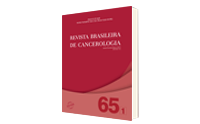Prevention and Care of Lymphedema after Breast Cancer: Understanding and Adherence to Physiotherapeutic Guidelines
DOI:
https://doi.org/10.32635/2176-9745.RBC.2019v65n1.273Keywords:
Breast Neoplasms, Lymphedema, Physical Therapy Modalities, Disease PreventionAbstract
Introduction: Lymphedema is the most common complication after breast cancer surgery. Early physiotherapeutic intervention is essential to improve quality of life and prevent such sequelae, but preventive guidelines can generate a feeling of incapacity and limitation. Objective: To identify the level of understanding and adherence of patients to physiotherapeutic guidelines in the prevention and care of lymphedema. Method: Descriptive, qualitative research, performed at Hospital de Cancer III the National Cancer Institute José Alencar Gomes da Silva (INCA). Fourteen patients were submitted to surgical treatment for breast cancer, and semi-structured interviews were performed. Results: The patients interviewed reported that they received guidance from the physiotherapy team and understood the importance of the recommendations. The main feelings aroused when asked about adherence to preventive care were worry, fear and panic, as well as the phantom of lymphedema. The interviewees recognized that soon after the surgery, they adhered more to preventive care, but that with the passage of time, this routine of care became more complicated, especially in front of their domestic commitments. Conclusion: We can see that these women coexist with a great fear of developing lymphedema, but they have a strong need to resume their domestic tasks. It was remarkable in the speeches how much the physiotherapeutic orientations generate anguish, sadness and sense of uselessness in these women. Physiotherapy should be attentive to the way it presents the preventive guidelines for lymphedema, and should always seek adaptation and never prohibition, in order to bring understanding and promote cooperation, sharing with women the responsibility for their self-care.









